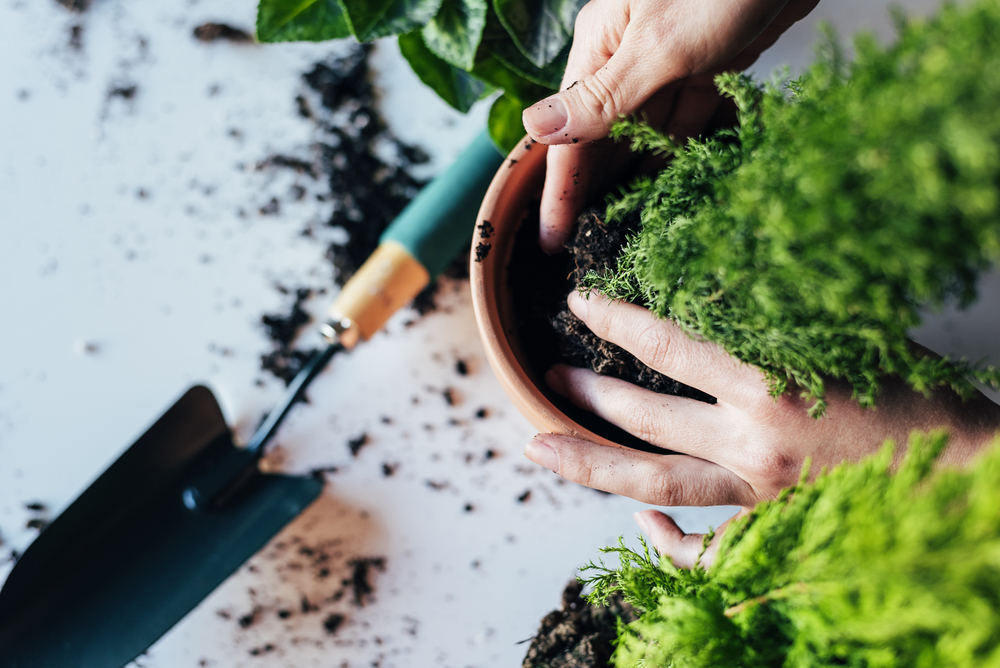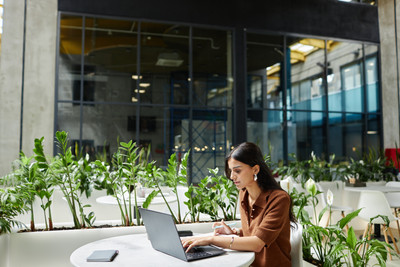Your Complete Guide on How to Use Planters & Pots
Posted by Jason Wyrwicz on Jul 15th 2020

Plants are proven to enhance mood and boost productivity. They're also fantastic for reducing allergens and pollutants in the air and can bring new layers to space design. However, in urban and interior settings, plants can be a rarity — if you've got nowhere to plant your flowers and greenery, how will you introduce plant life? Planters and pots are simple but effective solutions to this common problem. They allow you to bring life to areas previously devoid of plants.
But how do you use these planters?
This expert's guide will help you understand how to introduce planters to your world.
How to Find the Right Planter
The right planter for you depends on numerous factors:
- Your design choices and current aesthetic
- The plants you want to use
- Where you want to put the planter.
In general, we recommend either fiberglass or metal planters. These are lightweight but hard-wearing planters that can be used indoors and outdoors. They're also affordable materials that can form a variety of different potting planters, so there are no limits on the kind of products you can find.
Once you have the material, our next tip would be to consider what is more important:
- The plants you want
- The space you need to fill.
If you're dead-set on a particular plant — such as bamboo for a Zen garden — you'll want to focus your search on a planter that will house your plant well. In this case, we're talking about something with lots of depth to provide stability, and width to incorporate a good quantity of the plant. Whatever the plant, make sure you research how much space it needs to root and purchase an appropriate size planter. It's always better to buy a planter that is too large than too small. It's also a good idea to consider the design. What will this plant look good sat in? Putting a big and rounded-out plant in a square container may look out of place, compared to a nice curved pot.
However, if the planter’s location is more important than the plant within it, you'll want to consider the space and what would be the ideal fit. Around doors, for example, you'll be looking for something tall and narrow to shape and compliment the entrance, while for an outdoor pool area, you may want something that fits comfortably between sun loungers.
Picking the right planter is crucial, as it makes your life a lot easier further down the line. We would advise against picking planters that look nice and then trying to slot them in where possible. Understand how to use planters first — then buy what you need.
Where to Buy Your Planters
The best place to buy planters is from a specialist planter retailer like Pots, Planters & More. This is because you'll find the best product variety — and you'll be guaranteed the best rates. We're direct planter distributors, cutting out the middleman and eliminating associated fees. If you're planning big projects and are buying in bulk, you can also take advantage of our wholesale planters program, which will further reduce costs and save you money.
These are not the only benefits of using a planter specialist, however. Our business was founded on planters and pots, which means we're dedicated to providing high-quality planters built with only the best materials. We know what makes a planter great and won't settle for second-best, which means you won't need to either.
If you're in the market for planters, shop now to discover our vast range of premium items.
Where to Put Your Planters
You can put your planters anywhere!
Container gardening is growing in popularity thanks to its versatility. There is nowhere you can't place a planter. From desk spaces to hotel lobbies, all you have to do is match the right planter and space, or the right planter to your preferred plant.
There are few limitations on where you can locate planters. We'd only suggest that the ground be level. Ensure that you don't put heavy planters on carpets or delicate flooring if you're concerned with lasting wear, or on surfaces that may break under the strain of the plant's weight — a big planter on a narrow shelf, for example.
Other than these few restrictions, go ahead and build your container garden anywhere you see fit. Pot planting is great outdoors and indoors, in living areas and reception spaces — anywhere else you can find the space to bring new life with plants.
How to Prepare Your Planters
For fake plants, very little preparation is needed. Styrofoam can be placed in the bottom of planters, followed by stones or sand to add weight. However, if you're going to be using live plants, a few steps are necessary for the best results.
Start by assessing the base of the plant pot for drainage holes. If you are using your plant indoors, you'll need to fill in any drainage holes or place the planter on a drainage tray. Leaks can damage indoor flooring and should be avoided. If you're putting the planter outdoors, we recommend you make sure there is the drainage for excess water and that you do not fill in any drainage holes. Outdoor flooring is designed to withstand all kinds of weather and shouldn’t be troubled by a bit of water.
If no holes are present, you can simply drill them into the base of the planter.
Then you'll need to add potting soil, otherwise called potting mix. Potting soil has advantages over other types of soil in that it's nutrient-rich for better plant growth. It's also light, which gives plants space to develop compared to dense soil, such as soils gathered from a garden.
Before you plant, water the soil in your pot. Do this several times until you're confident the soil is moist all the way through. If possible, use a spray-nozzle hose pipe or watering can. Spray techniques are more effective at saturating all levels of soil with water than harsh streams. Once you've heavily saturated the soil, leave to rest for a few hours, so you don’t plant in over-watered soil.
How to Plant in Planters
First, move your planters to their final home. In their early stages of life in their new potted home, you don't want to be moving your plants around and disturbing root growth, so make sure you're planting in the location you intend to keep the planters — if this is possible. Place them wherever they'll be staying for the foreseeable future; a desk, deck, patio, office hallway, etc. We understand it may not be appropriate to start planting flowers in an area of high traffic — in the middle of a busy hotel lobby, for example. In this circumstance, you can plant off-site and bring planters in afterward.
However, in an ideal world, it's best to plant them where the pot will sit.
The planting process depends on the plants you are using. Every species has different requirements in terms of depth and space needed to thrive. We can't cover all the details here, so be sure to research the individual demands of the plants you are using and follow the advice on how to properly introduce them to your planters. Once planted, we recommend adding fertilizer to your soil if not already incorporated. Then, gently water your plants. This helps the roots contact the soil and binds them. It's an important step in helping your plants become luscious.
For finishing touches, you can layer decorative stones or gravel over the soil. This is a particularly popular choice for indoor planters.
How to Look after Planters
Potted planters are often focal points of exterior or interior design. Container gardening creates vibrant displays and enriches spaces. You'll want to keep your planting pots in great condition to ensure your design choice does not become a wasted effort.
If you've selected the right type of planter to use, such as aluminum or fiberglass, maintenance requirements will be low. Besides cleaning off any dirt and dust that accumulates, or marks from rain or grime if outside, your planters will need little attention. Pick a planting pot built to last, and you need not worry about it for years.
However, the plants within your planters are a different story.
Plants need proper and regular plant care. These are the biggest factors that will affect a plant’s life cycle:
- Water drainage holes — Not a problem if left outside, but if placed inside with drainage holes blocked, root rot can set in if plants are overwatered. If this does happen, it’s because there is too much water for the plant to absorb. The water gets trapped at the bottom, causing the roots to decay. A simple solution is to water little and often, and avoid watering if the soil at the top of the planter is still damp.
- Light — Plants require light to thrive. Without it, they can wilt and die. Sunlight produces the best light wavelengths for plants to encourage growth, as this is what they have evolved to use. However, artificial lighting can also support plant growth. Whatever light is used, make sure plants get plenty of it. Without it, your container plants will end up looking very sorry for themselves!
- Fertilize — Plants survive on nutrients in the soil that encases them. They take in these soil nutrients to live and grow, just as a human eats. In garden soil, these nutrients are replaced through natural processes, but in a container garden, the soil nutrients aren't replenished and can run out. Using plant food, you can restore the nutrients within your planters and keep plants lush.
- Temperatures —- Weather and climate can have a dramatic effect on plant health. Some plants can’t survive through a cold winter season, and others struggle and wilt in the heat. You'll want to make sure you keep your plants in areas where they'll thrive, which may mean moving delicate plants into shaded areas in the summer, or bringing them inside or under shelter in the winter.
- Welfare — Plants can be delicate things, particularly potted plants. They can be prone to infestations of vermin and insects, or creatures like slugs and snails that eat them. They can also accumulate bacteria and mold. Using preservative plant sprays and pesticides can help keep your plants healthy.
Has our guide on how to use planters got you set on planting? Not sure what exactly you'd do with your new planters, though? Read our blog on amazing planter design ideas to help get you inspired! Or, if you’re ready to start planting, browse our full range of planters.



